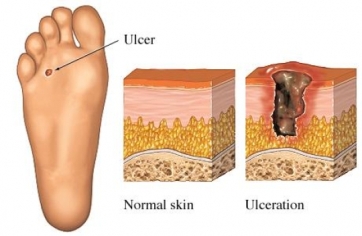Diabetes has reached epidemic proportions in North America. Two million Canadians (about 20 million in the US) have diabetes, and the number is expected to rise dramatically. At one time or another about 15-20% of patients with diabetes will need hospitalization with a diabetic foot complication. The conditions, which are of concern, are diabetic foot ulcers, severe infection and circulation problems in fingers and feet (peripheral circulation). Health budgets are stretched, as the cost of treating a single foot ulcer has been estimated at $2,183, so the total cost over the lifetime of current diabetics will exceed $650 million (about 6.5 billion $ in the US). Foot ulcers appear like a small item considering the fact that the need for amputation of a lower extremity is the next severe problem that can arise. The average patient who undergoes a below knee amputation will spend 84 days in hospital and another 38 days in rehabilitation.
To prevent the development of foot ulcers, it is important to screen diabetic patients for predisposing factors like the loss of protective sensation in the feet (diabetic neuropathy) as well as structural changes resulting in areas of increased pressure. A study conducted in southwestern Ontario found that only 15% of patients with type 2 diabetes were screened to identify those at risk for foot ulcers. Screening is the first step, after which a podiatrist will have to take over. Footwear prescribed by a podiatrist can be an avenue of prevention, but ongoing podiatric care as well. The small number of diabetic foot screenings shows that podiatric medicine has not been used as a tool to recognize and treat diabetic foot problems.
The proactive approach of seeking the input of a podiatrist early will translate into significant benefits for the patient with type 2 diabetes.
More information on complications of diabetes: http://nethealthbook.com/hormones/diabetes/complications-diabetes/
Reference: Parkhurst Exchange, December 2005, page 162
Last edited October 30, 2014






